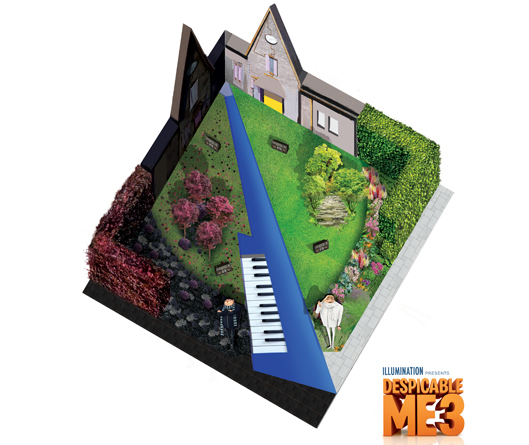
There are an abundance of design courses to choose from in Ireland but many are of questionable provenance, oftentimes they’re horticulture courses with a vague nod to design. While the vast majority of these design courses are fine for hobbyist and the DIYer, when they’re marketed as delivering industry standard qualifications, they do little more than cause frustration for enrollees, reduce the overall standard of design quality in the industry and undermine public perception and expectation. With so many questions hanging over the future of our economy, school leavers, up-skillers and career changers can ill afford to waste time and money taking courses that lead to nowhere. To save potential design students the heartache and financial loss of selecting the wrong course, I’ve put together a general guide, which outlines some of the things you should consider when choosing between course options.

What do you see yourself designing in five years time?
I’m often asked what the difference is between a landscape architect and a garden designer, and how knowing the difference should affect course selection. Generally speaking, a landscape architect is someone who works on large, complex schemes, often in the public realm and frequently as part of a team in an office environment. Becoming a landscape architect is a lengthy process involving several years of academic study, industry experience and formalized professional development. A garden designer typically works on smaller, privately owned spaces, is self employed and has a more hands-on approach to work. A garden designer can expect to spend two to three years studying for an undergraduate qualification but may also proceed to post graduate level. Although there is no specific, formalized professional development process for garden designers in Ireland, most will tell you that once you start your education it never finishes.
While both professions are underpinned by the same principles and employ the same technical information, software and similar approaches to design, they differ vastly in terms of working environment. When advising students on making a course selection, I typically ask them where they see themselves employed upon graduation. If they see themselves as self employed, working under your own steam, directly with private clients and contractors, I direct them towards garden orientated courses. If, on the other hand, they like the idea of working on large scale projects, within a team and in a more office-like environment, I steer them in the direction of landscape architecture.
It must be noted that while there are clear distinctions between the two professions, in recent years they have become far more fluid, with many professionals switching from one to the other. I originally studied horticulture, then garden design, then landscape architecture, before returning to garden design! The boundaries between landscape and garden are breaking down and rightly so.
When is a design course not a design course?
Usually when it’s a horticulture course with self esteem issues!
Having decided on the particular design route, it should be far easier to differentiate between options: but be warned, all courses are not equal. Just because a course features the word design in its title, does not automatically mean you will be able to successfully work as a professional designer or find suitable employment as part of a design team upon graduation. For example, a horticulture course that includes a design module will not provide sufficient instruction for establishing yourself as a practicing designer, just as a good design course will not provide sufficient horticultural knowledge to facilitate you becoming a professional gardener or nurseryman/woman. If you’re determined to make your living from design, ensure the course is design focused and that this is reflected in content, allocated teaching time and college resources.
What are the ingredients of a good design program?
5 parts design, 4 parts self directed exploration, 3 parts discussion, 2 parts drawing, 1 part practical, 2 parts procrastination, 1 part perspiration..!
This is the most important element to examine when selecting a suitable program, as an examination of content and its academic rigor will indicate how appropriate it is for your needs.
Design is a hugely complex area and although modules titles vary from course to course, they typically cover similar material. Any undergraduate program worth looking at should include computer applications (AutoCAD, PhotoShop, Sketch Up, Illustrator, Vectorworks, Word, PowerPoint etc), construction studies, plant science and design, draughting, history, industry experience, art (drawing, sketching, rendering, colour theory etc), environmental science, professional practice, surveying and planning. The subjects above should centre around specific design modules. They are the spokes and the hub is design.
Contact time…
Design knowledge is constructed socially so contact time is paramount.
An obvious point, but one that many ignore when choosing a course, is allocated teaching time for subjects. As the core subject, you should expect design to have a far greater allocation – if it doesn’t you’re looking at the wrong one! Although it is difficult to specify exactly what content you should expect to see within a design module, generally speaking, it should include a solid grounding in the key theories, concepts, methodlgies and techniques of 2 and 3D design; prior to a more in-depth exploration and examination of a specific medium (architecture, interior, landscape and so on). If in doubt, ask course a course representative for a breakdown.
Most good courses will often avoid direct contact with your chosen medium to start with, and will instead begin by addressing design fundamentals through a variety of artistic media (painting, sculpture, drawing, photography and so on). By doing so, they create a solid platform of design knowledge onto which any specialist information can be added to. Don’t be put off if you’re told to bring in modeling clay rather than scale rulers!
While the majority of design schools tend to have a guiding design philosophy, all should provide exposure to the diversity of design methodologies employed in the industry. I’m always wary of ones that offer instruction in only one particular method… grid, conceptual, pattern-assisted, SAD and so on. Education is about showing students the paths, it’s up to them to choose the right one for them.
How design should be taught…
It’s extremely difficult, if not impossible, to learn design from a book. Design education has it’s roots firmly in the apprenticeship model, with knowledge being constructed socially through observation, discussion, experimentation and input from colleagues and ’more able others’. As such most good courses provide ample ‘studio’ time for these interactions to take place. Most design schools do not have a specific book to work from, but will have a range of materials that students are expected to explore through reading and experimentation. This type of learning is very different from traditional schooling and can be both exhilarating and frustrating for new students.
How about assessments?
Design assessments should reflect the domain, as such they should be diverse.
Depending on the academic level of a course, you should expect to undertake a wide range of projects from small spatial design exercises to complex design/planning proposals for large areas. Generally speaking, projects should follow an upward trajectory moving from simple to complex and encompass a variety of design approaches, environments and connected subjects. In my experience, continual assessment is the most successful pathway for a design education. While researching assessment methods, make sure to ask if they are based in the real or paper landscape. Hypothetical situations are fine to start with, but dealing with real sites and clients provides students with invaluable experience.
Not such a cushy number?
If a programme manager tells you their design course is easy, you have the wrong course
If it’s easy, it’s not worth doing! Design programs by their very nature can be extremely challenging to undertake. In addition to scheduled lectures, design students can expect to spend at least the same amount of time at home working on assignments. Truly dedicated design students will tell you to forget about having a social life for the duration of your education! If you want to know how tough a course will be then ask successful graduates about it. It’s better to be prepared.
A BSc in Design from the Cowboy Institute…
Make sure the design course you are enrolling in is thoroughly assessed and independently accredited by a recognized body. Stand alone and private courses are often not independently validated, which is fine if you want to makeover your own garden but worthless to travel on and will be meaningless to a potential employer. In Ireland accreditation is offered by FETAC, HETAC, (QQI) BTEC and by a number of other awarding bodies and institutions. As yet, the Irish Landscape Institute and the Garden and Landscape Design Association do not offer any specific advice on course accreditation or selection. Even if a course is accredited you should still consider the actual content in detail. Many validation bodies allow providers to change course titles to suit they’re needs. You should also research progression links for graduates to other institutions or employers.
Rate their teachers…
We all remember the class we learned most from, it was the one with the passionate teacher who took a genuine interest in us and inspired us about their subject.
Good courses attract and employ good people with relevant experience and qualification. And within the design field institutions often encourage staff to remain active in the industry. As the old expression goes, good designers design, bad ones teach! Don’t be afraid to ask about teaching staff qualification and experience.
The learning environment…
A good design course should have ample facilities that are at least up to industry standard. These include computer suites, a library, design studios, common rooms and tutorial spaces. Visit college campuses to be sure.
What they know or who they know?
Good courses produce good employees and most retain strong ties to the industry front line.
Some courses have formalized industry feedback structures to ensure course material is kept up-to-date. Ask college staff about links to specific companies and/or representative bodies, ask where graduates are working, how easily they found work and see if it be possible to talk with them. Most good courses also incorporate a period of work experience as part of their structure, if they don’d you might ask why?
Avoiding an educational Cul de Sac…
As the industry has become increasingly complex, specialized and technically demanding, colleges have had to up their academic game and the diversity of courses offered. While a design student can expect to undertake an undergraduate design program in one institution, they may need/like to pursue a more specialized field of study elsewhere. To do so, their qualification needs to be recognized and it is extremely beneficial if their college has formalized progression links with other institutions.
Although it might be a little early for you to be thinking about further education, you should a least ensure that your course provides opportunities for progression.
A matter of time?
There are various ways you can pursue an education in design; full time, part time, evenings and so on, all of which have their advantages and disadvantages. In my opinion, once the various elements mentioned in this guide are delivered to a satisfactory level, delivery method shouldn’t matter. The above noted, I would not personally recommend undertaking a design course through distance learning. To develop strong design skills you need engagement, competition, support, encouragement and the challenge only direct interaction with others can give. You won’t get this sitting at home!
You can’t work without experience…
Never underestimate the value of industry experience. Many of the students I’ve worked with over the years built successful careers based on the industry experience they gained while in college. In fact, I would go so far as to say the single biggest contributing factor to graduates not succeeding in industry is neglecting opportunities to work in the field. In addition to allowing students the opportunity to get a flavor for what they’ll be involved with on a day to day basis, it also facilitates learning about the broader industry (nurseries, contractors, specialists and so on) and really helps to focus the mind. If industry experience is not a major component of a course you’re interested in, I’d think twice before enrolling.
Final note…
The information I’ve presented here is intended to assist you finding the right design course. It is based on personal experiences as a design student, lecturer and someone who has been involved with various design institutions. It must be noted that while the points I’ve highlighted are extremely important to consider when choosing a design program, they are by no means definitive. As with any design undertaking, time, money and effort are saved through planning, careful consideration of all relevant implications and follow up.

Barry Lupton MGLDA has been working in horticulture for almost 20 years. He holds multiple qualifications in horticulture, garden and landscape design and creative thinking. He is a fully accredited member of the Garden and Landscape Design Association (www.glda.ie) and has worked in various horticultural domains, including retail, commercial production and journalism. He has operated his own design practice for over a decade and continues to lecture in horticulture and design at Senior College Dun Laoghaire. He can be contacted at 086 349 22286 or via his website www.barrylupton.com
Source: Barry Lupton – How to Choose the Right Landscape/Garden Design Course – Barry Lupton MGLDA




